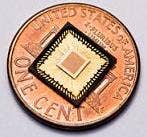A Computer Chip Based on Probability Not Binary (video)

Share
Traditional computer processing is based on 1 and 0, yes and no, but Lyric Semiconductor wants us to consider the power of 'maybe'. The Cambrdige, Massachusetts startup recently came out of stealth to announce the development of their new computer chip that calculates using probabilities. Lyric has used $20 million in DARPA and venture funding to rethink the way we process problems, from the basic architecture of its circuits all the way up to its software language . Everything is grey, not black and white. This new approach to computing has led to a new kind of chip that can handle probability based decisions quicker, using less space, and less energy. Instead of just cramming more gates on an integrated circuit like other computer chip designers, Lyric may have found a way to make those elements work harder. Check out a brief example of the chip's power in the video below.
Spam filtering, product suggestions, identity verification...a large portion of modern computer processing power is spent on problems that rely on computers to analyze the probability of a situation. The Lyric approach uses probability natively, allowing for a quicker solution to these problems. In the video below, a program attempts to determine how many users are typing on a keyboard, and in what order. Instead of trying to find the definite solution, it seeks the most likely solution...and ends up with the right answer. Pretty cool.
A big application for Lyric's new technology will be error correction. 30 nm NAND flash memory will typically have 1 bit wrong per 1000. As we reach to build smaller and smaller chips, that error rate is likely to increase. Lyric Error Correction (LEC) uses their probability processing to counter for mistakes in memory processing. LEC gets the same results as traditional binary chips but in an area 30 times as small, and with only 10% of the power.

Lyric Error Correction cleans up mistakes in stored memory. LEC allows cheap flash drives (with higher error rates) to be used in small portable systems like phones.
While still built on silicon, Lyric's probability chip uses a completely new architecture for gates. The chip doesn't process a long series of opens and closed connections as ones and zeros. Instead, there's a great connectivity between nodes, variables talk to each other, creating a highly parallel processing method. Instead of Boolean logic (And, Or, Not) the chip relies on Bayesian probability logic. At every step in the process, Lyric had to rethink how computer processing was done. That means their approach has the capability to produce a revolutionary advance in computing.
Be Part of the Future
Sign up to receive top stories about groundbreaking technologies and visionary thinkers from SingularityHub.


It also means that everything they do is relatively untested. What kind of artifacts does probability processing introduce into computing? Are there strange limits on power consumption, environmental sensitivities, or long term failure concerns? We don't even know if they'll be able to scale up production to meet demand. So while Lyric's potential for more powerful processing has generated a lot of buzz, we need to be cautious in our expectations. It may take a long time before we know if this technology is truly viable.
That being said, I love to consider what probability based processing could mean. It could let us solve problems in a way akin to how the universe views the basic physical interactions between its smallest particles. Perhaps it will have an impact in how we model biological systems. Maybe it will affect how we simulate the brain. We'll have to wait and see what Lyric can accomplish in the years ahead.
Personally, I'm hoping for an Infinite Improbability Drive.
[image credits: Lyric Semiconductor]
Source: lyric
Related Articles

How Scientists Are Growing Computers From Human Brain Cells—and Why They Want to Keep Doing It

These Brain Implants Are Smaller Than Cells and Can Be Injected Into Veins

This Wireless Brain Implant Is Smaller Than a Grain of Salt
What we’re reading
